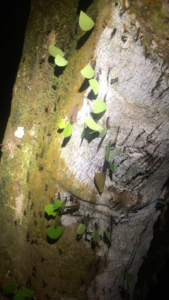Ant Foraging Behavior: A field exercise for student groups studying leaf cutter ant behavior at BFREE
Author, Amy Treonis, Department of Biology, University of Richmond, Richmond, VA
Introduction
Leaf cutter ants are unmissable denizens of the rainforest, and a visit to BFREE is not complete without spending some time observing their activities. Leaf cutter ants live in complex, agrarian societies. They harvest leaves, bring them back to their underground nests, which can host millions of ants, and feed the leaves to a cultivated, specialized fungus. The ants feed on the swollen tips of fungal hyphae, called gonglydia. The fungi live in obligate mutualism with the ants. Bacteria are also cultivated on the ants that produce antibiotics that help that keep foreign microbes out of the fungus culture.

Leaf cutter ants moving at night
Leaf cutter ants are represented by 47 species from the genera Atta or Acromyrmex, including the widely-distributed, neotropical Atta cephalotes. There are four size classes of workers in a leaf cutter ant society: minims, minors, midiae, and majors. Each tends to perform different tasks, with minims taking care of the fungus garden, minors protecting the foragers, midiea being the primary foragers and leaf cutters, and majors acting as soldiers to defend the nest from intruders and also cleaning the foraging path of debris. While the activities of these ants are a key aspect of rain forest ecosystem functioning, particularly with respect to soil building, these ants are also pests in agriculture. It is important to note that there are many species of ants in Belize, but not all of them are leaf cutters.
Leaf cutter ants do not feed indiscriminately. They harvest from only a subset of plant species in their environment, and they may travel good distances (several hundred meters) to forage on a specific plant. After foraging for a few days on one plant, the ants may switch to a new individual or a new species, possibly due to an uptick in plant defense compound production.
Leaf cutter ants are a particularly amenable system for student-led research projects. With just a little observation, students can generate their own hypotheses and experiments. In this curriculum packet, ideas are offered for areas of experimentation and an example experiment is provided.
Principal Ecological Question Addressed: What factors influence the foraging behavior of leaf cutter ants?
Required Class Time: If students are designing their own experiments at BFREE, time should be allocated for  students to observe the ants, generate hypotheses, and design experiments. The example experiment described below required about two hours of time in the field to collect leaves, measure their thickness, and imaging. Additional class time is required for image analysis, data processing and interpretation.
students to observe the ants, generate hypotheses, and design experiments. The example experiment described below required about two hours of time in the field to collect leaves, measure their thickness, and imaging. Additional class time is required for image analysis, data processing and interpretation.
Documents Provided:
Leaf Cutter Ants Field Study – Full Project Description
Literature Consulted and Additional Resources:
AIMS: Analyzing Images to Learn Mathematics and Statistics:
Cherrett JM. 1972. Some factors involved in the selection of vegetable substrate by Atta cephalotes (L.) (Hymenoptera: Formicidae) in tropical rain forest. Journal of Animal Ecology 41:647-660.
Garrett, RW, Carlson, KA, Goggans, MS, Nesson, MH, Christopher A. Shepard, CA & Schofield, RMS. 2016. Leaf processing behaviour in Atta leafcutter ants: 90% of leaf cutting takes place inside the nest, and ants select pieces that require less cutting. Royal Society Open Science
Hölldobler B & Wilson EO. 2011. The Leafcutter Ants: Civilization by Instinct. New York, WW Norton. 157 pp.
Moll K, Federle W & Roces F. 2012. The energetics of running stability: costs of transport in grass-cutting ants depend on fragment shape. Journal of Experimental Biology 215:161-168.
Roces F & Hölldobler B. 1994. Leaf density and a trade-off between load-size selection and recruitment behavior in the ant Atta cephalotes. Oecologia 97: 1-8.
Rudolph SG & Loudon C. 1986. Load size selection by foraging leaf-cutter ants (Atta cephalotes). Ecological Entomology 11:401-410.
Wirth R, Beyschlag W, Ryel RJ, Holldobler B. 1997. Annual foraging of the leaf-cutting ant Atta colombica in a semideciduous rain forest in Panama. Journal of Tropical Ecology 13:741-757.



Leave a Reply
Want to join the discussion?Feel free to contribute!